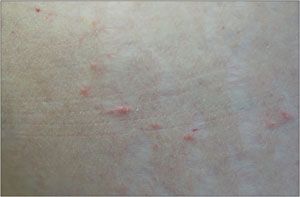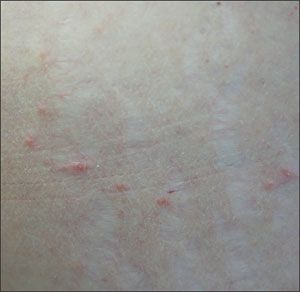- Clinical Technology
- Adult Immunization
- Hepatology
- Pediatric Immunization
- Screening
- Psychiatry
- Allergy
- Women's Health
- Cardiology
- Pediatrics
- Dermatology
- Endocrinology
- Pain Management
- Gastroenterology
- Infectious Disease
- Obesity Medicine
- Rheumatology
- Nephrology
- Neurology
- Pulmonology
What caused this intensely pruritic eruption?
For 1 month, a 54-year-old woman has had an intensely pruritic eruption on her abdomen, arms, and anterior thighs. She has long-standing hypertension and type 2 diabetes mellitus, which are treated with an angiotensin-converting enzyme inhibitor/diuretic and an oral hypoglycemic agent.
Case 2:
Is this scaly rash a drug reaction-or something else?
How do you explain this asymptomatic rash on a woman’s breast?
What clues in the history point to the cause of this itchy, scaly eruption?
For 1 month, a 54-year-old woman has had an intensely pruritic eruption on her abdomen, arms, and anterior thighs. She has long-standing hypertension and type 2 diabetes mellitus, which are treated with an angiotensin-converting enzyme inhibitor/diuretic and an oral hypoglycemic agent.

Which of the following would you include in the differential?
A. Scabies.
B. Grover disease.
C. Guttate psoriasis.
D. Pityrosporum folliculitis.
E. Lichen planus.
Bonus question: There is something missing from the history. What question would you ask this patient?
Case 2: Sarcoptic mange

The answer to the question “Do you have any pets?” was missing from the history. This patient’s 6-year-old dog had leukemia and received chemotherapy. Subsequently, the dog developed a rash, which was diagnosed as sarcoptic mange, A.
The term “scabies” refers to mite infestations by either Sarcoptes scabiei or closely related mite species. Although S scabiei can infect humans and cats, it tends not to persist on these hosts. When “sarcoptic mange” or “scabies” is described in cats, these terms usually refer to infection by Notoedres cati, a closely related mite. Notoedric mange in cats generally produces facial itching and scabbing.
Dips (amitraz), pour-on miticides (alcohol-based ivermectin), and oral products (milbemycin) are effective treatments for sarcoptic mange in animals. This patient’s dog and house were treated, and her rash gradually resolved over a 2-week period without the formation of new lesions. Because she had intense pruritus, she was treated with prednisone in a tapering dosage, ivermectin, and topical precipitated sulfur in triamcinolone cream.
